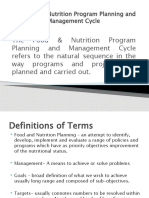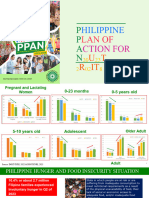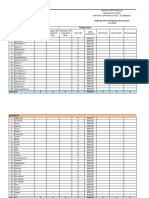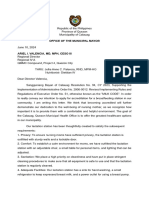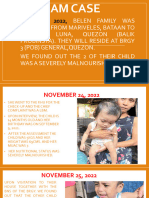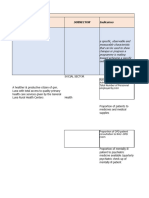Module 7 MKK
Uploaded by
roseannurakModule 7 MKK
Uploaded by
roseannurakModule 7: Phase 4: Re-planning of the NPM Cycle 1
PHASE 4 OF NPM: RE-PLANNING
The previous module emphasized the importance of conducting monitoring and evaluation.
The results of the monitoring and evaluation are inputs in designing for sustainability and
re-planning (Figure 7.1). In this module, you will be equipped with knowledge and skills to do
re-planning based on the results of monitoring and evaluation.
Figure 7.1. LNC members from Region VI re-planning their activities based on PIR results.
Module 7: Phase 4: Re-planning of the NPM Cycle 2
TABLE OF CONTENTS
Lesson Title Page
1 Re-planning of Local Nutrition Action Plan (LNAP) 5
2 Assessing Sustainability 8
LIST OF TABLE, FIGURES AND MATRICES
Table Title Page
7.1 Schedule for the preparation of LNAP and AIP in a three-year 7
period
Figure
7.1 LNC members from Region VI re-planning their activities based on 2
PIR results
7.2 Phase 4: Re-planning of the NPM Cycle 6
Matrix
7.1 Assessment of nutrition interventions during re-planning 8
7.2 Some questions for the different areas of sustainability 8
7.3 Assessing the different aspects of each step of LNAP preparation 9
during re-planning
Module 7: Phase 4: Re-planning of the NPM Cycle 3
NUTRI WORKERS ONLINE: Module Seven
ACRONYMS
AIP Annual Investment Program
BNS Barangay Nutrition Scholar
ELA Executive Legislative Agenda
LGU Local Government Unit
LNAP Local Nutrition Action Plan
LNC Local Nutrition Committee
M&E Monitoring and Evaluation
NAO Nutrition Action Officer
NGO Non-Government Organization
NPM Nutrition Program Management
PIR Plan Implementation Review
WHO World Health Organization
Module 7: Phase 4: Re-planning of the NPM Cycle 4
LESSON 1
Re-planning of Local Nutrition Action Plan (LNAP)
Understanding Re-planning of LNAP
Figure 7.2 shows that re-planning is the last phase of the Nutrition Program Management
(NPM) cycle.
After the evaluation of the LNAP has been conducted, use results as basis in scaling up and
improving nutrition interventions. You can also use it in revising the design, process, materials
or overall strategies, and activities that are not working well through re-planning.
Why is there a need to re-plan? The following conditions warrant re-planning:
1. Availability of new technologies or standard recommendations, e.g., introduction of the
new World Health Organization (WHO) growth standard;
2. New political leadership (sympathetic or unsympathetic to nutrition program, new
Executive Legislative Agenda (ELA), new budget);
3. Reduced or increased budget/funding allocation;
4. Monitoring and evaluation (M&E) reports noted the intervention was a failure or
success;
5. New institutional arrangement/s;
6. Need to integrate lessons learned;
7. Need to integrate sectoral objectives and interventions;
8. Increase or decrease prevalence of malnutrition;
9. Disapproval of some parts of LNAP in the Annual Investment Program (AIP) by the
Sangguniang Bayan or Sangguniang Panlalawigan; and
10. Occurrence of emergency or disaster situations.
Module 7: Phase 4: Re-planning of the NPM Cycle 5
Figure 7.2. Phase 4: Re-planning of the NPM Cycle.
Steps in Re-planning
The following activities are carried out in re-planning:
1. Conduct a situation analysis;
2. Adopt or revise existing goals and objectives. Align goals and objectives on the results
of the situational analysis;
3. Re-strategize to identify which interventions should be continued without modification
or continued with changes or started or stopped/terminated; and
4. Package the revised plan and subject it for adoption.
When to re-plan?
Conduct re-planning during the first quarter of the plan period after the AIP has been
approved and mid-year when results of M&E are analyzed. The general timeline depicted in
Table 7.1 is a guide in scheduling the re-planning activity. The preparation of the AIP for
nutrition should be ahead of the regular AIP, which starts in July of each year.
Module 7: Phase 4: Re-planning of the NPM Cycle 6
Table 7.1. Schedule for the preparation of LNAP and AIP in a three-year period.
YEAR 1 YEAR 2 YEAR 3
Preparation of AIP Year 2 Re-planning of AIP Year 2 Re-planning of AIP Year 3
(April to June) (January to March) (January to March)
Planning for AIP Year 3 Formulation of LNAP for
(April to June) 3 years and AIP Year 1
(April to June)
*Note: Formulation and adoption of the 3-year LNAP and preparation of AIP Year 1 must be done on Year 0
Module 7: Phase 4: Re-planning of the NPM Cycle 7
LESSON 2
Assessing Sustainability
After completing Lesson 2, you should be able to discuss sustainability in the context of local
nutrition program management and assess sustainability of nutrition interventions.
Sustainability in Local Nutrition Program Management
Conduct an assessment of the sustainability of the nutrition intervention/s and LNAP. Use
results of the assessment, together with that of the evaluation in re-designing the nutrition
intervention and of the entire LNAP.
The following steps can facilitate the assessment of sustainability of nutrition interventions
during re-planning:
1. List the existing nutrition projects in your area;
2. Cluster the intervention which need to be continued without modification and why;
continued with modification and how; stopped and why; and should be started and
how; and
3. Use Matrix 7.1 to write your answers.
Matrix 7.1. Assessment of nutrition interventions during re-planning.
Continue without Continue with
Stop and Why Start and How
modification modification
Assess the sustainability of the nutrition intervention by answering the questions per key area
of sustainability listed in Table 7.2.
Matrix 7.2. Some questions for the different key areas of sustainability.
Key Area Questions
Institutional sustainability • What measures have the LNC taken in order to sustain plan
outputs?
• Has the LGU established a nutrition office? Are there
permanent or full-time Nutrition Action Officers (NAOs) with
staff?
Module 7: Phase 4: Re-planning of the NPM Cycle 8
Key Area Questions
• Are there adequate Barangay Nutrition Scholars (BNSs) to
cater to all households?
• Is the legislative body supportive to the nutrition program in
terms of passing ordinances/resolutions on nutrition and
providing budgetary support/human resource?
Financing sustainability • Is the funding source sufficient to carry out the necessary
future activities?
• Is the LNAP adequately funded through local appropriation?
• How strong is the dependence on outside funding?
• Are funding sources stable?
• Are there non-monetary (or in kind) resources provided for
the implementation of the nutrition plan?
• What resource mobilization activities were undertaken to
address financing gap?
Technical sustainability • Are the knowledge, skills, values, and technology transferred
during the program or project implementation firmly
established with the LGU?
• Is there a mechanism to share the individual knowledge and
skill among the implementers?
• Is there necessary and sufficient equipment and tools to
practice the skill?
• Is there capacity to maintain equipment?
Social acceptance • Are nutrition interventions acceptable to the target
stakeholders?
• Do intended stakeholders utilize services available?
• Is there wide participation and clear-shared purpose?
Environmental • Will the implementation of the nutrition intervention
sustainability damage the environment?
The assessment of LNAP for re-planning purposes can be done by identifying the activities of
nutrition program management which need to be continued without modification and why;
continued with modification and how; stopped and why; and started and how (Matrix 7.3).
Matrix 7.3. Assessing the different aspects of each step of LNAP preparation during re-planning.
Continue
Factors to be Continue with
without Stop and Why Start and How
assessed modification
modification
LNC Structure
Assessment of the
nutrition situation
Setting goals and
objectives
Module 7: Phase 4: Re-planning of the NPM Cycle 9
Continue
Factors to be Continue with
without Stop and Why Start and How
assessed modification
modification
Identification and
prioritization of
intervention
Preparation of
work plan or plan
of operation
Designing of
monitoring and
evaluation system
Plan packaging
Legislation/
Adoption
Resource
allocation
Integration in
other local
development
plans and budgets
Module 7: Phase 4: Re-planning of the NPM Cycle 10
You might also like
- FINAL - Strengthening of The LGU Nutrition Program Creation of LGU Nutrition Offices100% (1)FINAL - Strengthening of The LGU Nutrition Program Creation of LGU Nutrition Offices34 pages
- Module 3. Lesson 1. Understanding Nutrition Program Management-2100% (3)Module 3. Lesson 1. Understanding Nutrition Program Management-220 pages
- LDIP - LNAP Workshop Facilitators Notes (8.30.2019) PDF100% (3)LDIP - LNAP Workshop Facilitators Notes (8.30.2019) PDF316 pages
- 6 Food and Nutrition Program Planning and Management100% (1)6 Food and Nutrition Program Planning and Management81 pages
- Capacity Development For Local Government Units On Nutrition Program ManagementNo ratings yetCapacity Development For Local Government Units On Nutrition Program Management25 pages
- Bangladesh National Nutrition Services: Assessment of Implementation StatusFrom EverandBangladesh National Nutrition Services: Assessment of Implementation StatusNo ratings yet
- 2022 Local Nutrition Planning-ShortenedNo ratings yet2022 Local Nutrition Planning-Shortened59 pages
- Guidelines for Developing a National Strategy for Plant Genetic Resources for Food and AgricultureFrom EverandGuidelines for Developing a National Strategy for Plant Genetic Resources for Food and AgricultureNo ratings yet
- Parenting Education in Indonesia: Review and Recommendations to Strengthen Programs and SystemsFrom EverandParenting Education in Indonesia: Review and Recommendations to Strengthen Programs and Systems5/5 (1)
- SAMPLE FILLED OUT Worksheet 8. Re Entry Planning100% (2)SAMPLE FILLED OUT Worksheet 8. Re Entry Planning2 pages
- Ethiopia Health Extension Program: An Institutionalized Community Approach for Universal Health CoverageFrom EverandEthiopia Health Extension Program: An Institutionalized Community Approach for Universal Health Coverage5/5 (1)
- Picture A Community Where You Are To Be Working As A Community OrganizerNo ratings yetPicture A Community Where You Are To Be Working As A Community Organizer3 pages
- Rethinking School Feeding: Social Safety Nets, Child Development, and the Education SectorFrom EverandRethinking School Feeding: Social Safety Nets, Child Development, and the Education SectorNo ratings yet
- Guidelines for Assessing Nutrition-Related Knowledge, Attitudes and PracticesFrom EverandGuidelines for Assessing Nutrition-Related Knowledge, Attitudes and PracticesNo ratings yet
- A Possible Framework For NG-CARES DLI 1.4 Nutrition Sector by Josephine Ayuk PH.DNo ratings yetA Possible Framework For NG-CARES DLI 1.4 Nutrition Sector by Josephine Ayuk PH.D33 pages
- A Trainer’S Guide for Preclinical Courses in Medicine: Series I Introduction to MedicineFrom EverandA Trainer’S Guide for Preclinical Courses in Medicine: Series I Introduction to MedicineNo ratings yet
- Developing Learner-Centered Teaching: A Practical Guide for FacultyFrom EverandDeveloping Learner-Centered Teaching: A Practical Guide for FacultyNo ratings yet
- Improving Effectiveness and Outcomes for the Poor in Health, Nutrition, and Population: An Evaluation of World Bank Group Support Since 1997From EverandImproving Effectiveness and Outcomes for the Poor in Health, Nutrition, and Population: An Evaluation of World Bank Group Support Since 1997No ratings yet
- Importance of Nutrition Intervention Planning100% (1)Importance of Nutrition Intervention Planning16 pages
- Complete Download (eBook PDF) Nutrition Counseling and Education Skills: A Guide for Professionals 7th Edition PDF All Chapters100% (6)Complete Download (eBook PDF) Nutrition Counseling and Education Skills: A Guide for Professionals 7th Edition PDF All Chapters46 pages
- (LNAP Refresher) Session 1. Overview of LNAP GuidelinesNo ratings yet(LNAP Refresher) Session 1. Overview of LNAP Guidelines26 pages
- Strengthening Post-Ebola Health Systems: From Response to Resilience in Guinea, Liberia, and Sierra LeoneFrom EverandStrengthening Post-Ebola Health Systems: From Response to Resilience in Guinea, Liberia, and Sierra LeoneNo ratings yet
- Template Equipment Inventory - General LunaNo ratings yetTemplate Equipment Inventory - General Luna22 pages
- Letter of Intent - Calauag LGU For MBFW CertificationNo ratings yetLetter of Intent - Calauag LGU For MBFW Certification2 pages
- Module 2: Advancing Core Values and Skills of Nutrition Workers 1100% (1)Module 2: Advancing Core Values and Skills of Nutrition Workers 141 pages
- General-Luna Elem Districtschool NS Baseline Consolidation Sy2023-2024No ratings yetGeneral-Luna Elem Districtschool NS Baseline Consolidation Sy2023-202499 pages
- Declaration of Heirship and Sale - EnclonarNo ratings yetDeclaration of Heirship and Sale - Enclonar2 pages
- Bangalore Development Authority - Bengaluru Masterplan 2031No ratings yetBangalore Development Authority - Bengaluru Masterplan 203156 pages
- United States v. Michelle Mallard, 4th Cir. (2015)No ratings yetUnited States v. Michelle Mallard, 4th Cir. (2015)6 pages
- Bioresources and Bioprocess in Biotechnology for a Sustainable Future 1st Edition Leonardo Sepúlveda Torre - Download the ebook now and own the full detailed content100% (1)Bioresources and Bioprocess in Biotechnology for a Sustainable Future 1st Edition Leonardo Sepúlveda Torre - Download the ebook now and own the full detailed content64 pages
- Minors Travelling Abroad Consent To Travel2No ratings yetMinors Travelling Abroad Consent To Travel21 page
- Compensation Management: Performance and Reward Management Kmbnhr04No ratings yetCompensation Management: Performance and Reward Management Kmbnhr0419 pages
- FINAL - Strengthening of The LGU Nutrition Program Creation of LGU Nutrition OfficesFINAL - Strengthening of The LGU Nutrition Program Creation of LGU Nutrition Offices
- Module 3. Lesson 1. Understanding Nutrition Program Management-2Module 3. Lesson 1. Understanding Nutrition Program Management-2
- LDIP - LNAP Workshop Facilitators Notes (8.30.2019) PDFLDIP - LNAP Workshop Facilitators Notes (8.30.2019) PDF
- 6 Food and Nutrition Program Planning and Management6 Food and Nutrition Program Planning and Management
- Capacity Development For Local Government Units On Nutrition Program ManagementCapacity Development For Local Government Units On Nutrition Program Management
- Bangladesh National Nutrition Services: Assessment of Implementation StatusFrom EverandBangladesh National Nutrition Services: Assessment of Implementation Status
- Guidelines for Developing a National Strategy for Plant Genetic Resources for Food and AgricultureFrom EverandGuidelines for Developing a National Strategy for Plant Genetic Resources for Food and Agriculture
- Parenting Education in Indonesia: Review and Recommendations to Strengthen Programs and SystemsFrom EverandParenting Education in Indonesia: Review and Recommendations to Strengthen Programs and Systems
- Ethiopia Health Extension Program: An Institutionalized Community Approach for Universal Health CoverageFrom EverandEthiopia Health Extension Program: An Institutionalized Community Approach for Universal Health Coverage
- Picture A Community Where You Are To Be Working As A Community OrganizerPicture A Community Where You Are To Be Working As A Community Organizer
- Rethinking School Feeding: Social Safety Nets, Child Development, and the Education SectorFrom EverandRethinking School Feeding: Social Safety Nets, Child Development, and the Education Sector
- Guidelines for Assessing Nutrition-Related Knowledge, Attitudes and PracticesFrom EverandGuidelines for Assessing Nutrition-Related Knowledge, Attitudes and Practices
- A Possible Framework For NG-CARES DLI 1.4 Nutrition Sector by Josephine Ayuk PH.DA Possible Framework For NG-CARES DLI 1.4 Nutrition Sector by Josephine Ayuk PH.D
- A Trainer’S Guide for Preclinical Courses in Medicine: Series I Introduction to MedicineFrom EverandA Trainer’S Guide for Preclinical Courses in Medicine: Series I Introduction to Medicine
- Developing Learner-Centered Teaching: A Practical Guide for FacultyFrom EverandDeveloping Learner-Centered Teaching: A Practical Guide for Faculty
- Improving Effectiveness and Outcomes for the Poor in Health, Nutrition, and Population: An Evaluation of World Bank Group Support Since 1997From EverandImproving Effectiveness and Outcomes for the Poor in Health, Nutrition, and Population: An Evaluation of World Bank Group Support Since 1997
- PMI-PgMP Exam Navigator: Expert Q&A with Detailed ExplanationsFrom EverandPMI-PgMP Exam Navigator: Expert Q&A with Detailed Explanations
- Complete Download (eBook PDF) Nutrition Counseling and Education Skills: A Guide for Professionals 7th Edition PDF All ChaptersComplete Download (eBook PDF) Nutrition Counseling and Education Skills: A Guide for Professionals 7th Edition PDF All Chapters
- A Comprehensive Guide to Passing the NCLEX-RNFrom EverandA Comprehensive Guide to Passing the NCLEX-RN
- (LNAP Refresher) Session 1. Overview of LNAP Guidelines(LNAP Refresher) Session 1. Overview of LNAP Guidelines
- Strengthening Post-Ebola Health Systems: From Response to Resilience in Guinea, Liberia, and Sierra LeoneFrom EverandStrengthening Post-Ebola Health Systems: From Response to Resilience in Guinea, Liberia, and Sierra Leone
- Letter of Intent - Calauag LGU For MBFW CertificationLetter of Intent - Calauag LGU For MBFW Certification
- Module 2: Advancing Core Values and Skills of Nutrition Workers 1Module 2: Advancing Core Values and Skills of Nutrition Workers 1
- General-Luna Elem Districtschool NS Baseline Consolidation Sy2023-2024General-Luna Elem Districtschool NS Baseline Consolidation Sy2023-2024
- Bangalore Development Authority - Bengaluru Masterplan 2031Bangalore Development Authority - Bengaluru Masterplan 2031
- United States v. Michelle Mallard, 4th Cir. (2015)United States v. Michelle Mallard, 4th Cir. (2015)
- Bioresources and Bioprocess in Biotechnology for a Sustainable Future 1st Edition Leonardo Sepúlveda Torre - Download the ebook now and own the full detailed contentBioresources and Bioprocess in Biotechnology for a Sustainable Future 1st Edition Leonardo Sepúlveda Torre - Download the ebook now and own the full detailed content
- Compensation Management: Performance and Reward Management Kmbnhr04Compensation Management: Performance and Reward Management Kmbnhr04

















